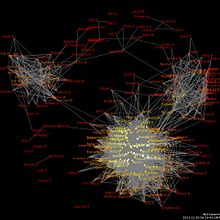
Back تحليل الشبكات الاجتماعية Arabic شیکاریی تۆڕە کۆمەڵایەتییەکان CKB Social media analytics English Sare sozialen analisia EU تحلیل شبکههای اجتماعی FA Sosiaalinen verkostoanalyysi Finnish אנליזת רשתות חברתיות HE Analyse av sosiale nettverk NB Analiza sieciowa Polish Análise de mídia social Portuguese

Sosiale-netwerk-analise (SNA) is die sosiologiese been van die netwerkteorie, wat 'n benaderingswyse tot komplekse sisteme binne die sisteem- of stelselteorie is en ook as die grafiekteorie bekendstaan. Die oogmerk van SNA is die ontleding van sosiale netwerke, byvoorbeeld vriendskapsnetwerke of professionele samewerkingsnetwerke.
SNA het veral ontwikkel uit die werke van Jacob Moreno, wie se Who shall survive? (1934)[1] "a signal event in the history of social network analysis" was.[2] Freeman[3] merk egter op dat SNA se wortels kompleks is en teruggevoer kan word na die werke van onder andere Almack,[4] Wellman,[5] Chevaleva-Janovskaja,[6] Bott,[7] Hubbard[8] en Hagman[9] (kyk ook Borgatti et al.[10] en Prell[11]). Moreno het sy benaderingswyse sosiometrie genoem, iets wat die grafiese uitbeelding van sosiale netwerke deur middel van sogenaamde sosiogramme ingesluit het. Hy voer aan dat hierdie tegniek "enquire into the evolution and organization of groups and the position of individuals within them".[12] Sosiometrie word algemeen as ’n belangrike voorloper van die netwerkteorie aanvaar.[13] ’n Ander seminale teoretikus in terme van die netwerkteorie, naamlik Kurt Lewin, het die menslike beweegruimte as ’n "veld" beskou (en het ’n direkte invloed op die latere Pierre Bourdieu uitgeoefen). Lewin[14] skryf: "Whether or not a certain type of behavior occurs depends not on the presence or absence of one fact or of a number of facts as viewed in isolation but upon the constellation (structure and forces) of the specific field as a whole. The ‘meaning’ of the single fact depends upon its position in the field; or, to say the same in more dynamical terms, the different parts of a field are mutually interdependent."
Dit was egter eers in die 1960’s en 1970’s dat SNA as ’n selfstandige spesialisveld binne die sosiologie as vakgebied ontwikkel het, veral aan Harvard se Departement Sosiologie onder Harrison White, waar hy byvoorbeeld in samewerking met Barry Wellman, Stanley Milgram en Mark Granovetter was. Sedertdien is SNA op ’n groot verskeidenheid terreine toegepas; trouens, Freeman[15] skryf dat SNA gekenmerk word deur sy wye verskeidenheid van toepassings. Die netwerkteorie word binne die sosiologie, letterkunde, sielkunde, antropologie, opvoedkunde en vele ander terreiene toegepas.
- ↑ Moreno, Jacob L. 1934. Who shall survive? Washington, DC: Nervous and Mental Disease Publishing Company
- ↑ Freeman, L. C. 2004. The development of Social Network Analysis. A study in the sociology of science. Vacouver: Empirical Press
- ↑ Freeman, L. C. 2004. The development of Social Network Analysis. A study in the sociology of science. Vacouver: Empirical Press
- ↑ Almack, J. C. 1922. The influence of intelligence on the selection of associates. School and Society 16:529- 530
- ↑ Wellman, B. 1926. The school child’s choice of companions. Journal of Educational Research, 14:126-132
- ↑ Chevaleva-Janovskaja, E. 1927. Groupements spontanés d’enfants à l’age préscolaire. Archiv es de Psychologie, 20:219-223
- ↑ Bott, H. 1928. Observation of play activities in a nursery school. Genetic Psychology Monographs, 4:44-88
- ↑ Hubbard, R. M. 1929. A method of studying spontaneous group formation. In Thomas, D. S. (ed.). 1929. Some new techniques for studying social behavior, New York: Teachers College, Columbia University, Child Development Monographs
- ↑ Hagman, E. P. 1933. The companionships of preschool children. University of Iowa Studies in Child Welfare, 7:10-69
- ↑ Borgatti, S. P., Mehra, A., Brass, D. J., & Labianca, G. 2009. Network Analysis in the Social Sciences. Science, 323:892-895
- ↑ Prell, C. 2012. Social Network Analysis. History, theory and methodology. London: Sage
- ↑ Moreno, Jacob L. 1934. Who shall survive? Washington, DC: Nervous and Mental Disease Publishing Company
- ↑ Prell, C. 2012. Social Network Analysis. History, theory and methodology. London: Sage
- ↑ Lewin, K. 1939. Field Theory and experiment in social psychology: Concepts and methods. American Journal of Sociology, 44(6), 868-896
- ↑ Freeman, L. C. 2004. The development of Social Network Analysis. A study in the sociology of science. Vacouver: Empirical Press